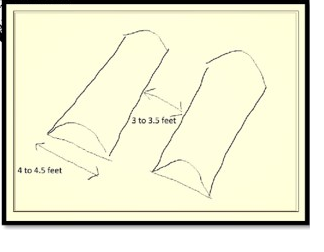This is the most convenient method and it costs almost zero.

As we discussed in the section “compost”, soil contains a variety of microbes. In the pile, there is constant contact with the soil. Hence this method does not require much inputs from us. Soil takes care of most of the things.
What you need
- Space to create pile
- A culture (Soil/ Cow dung/ Compost/ Microbe Mixture)
How to go about it?
Select a spot which is near water tap or any water source.
Pile can be of any shape. Since we need to water it, it should not be too huge. Water should reach the entire pile. Hence size should be such that person should be able to reach the centre of the pile while standing by it.

This is an efficient and convenient method. Create pile in rectangular shape. Its length can be anything. Width should be maximum 4 to 4.5 feet.
Start depositing dry leaves. When pile is full, create the second pile parallel to it. Leaves around 3 to 3.5 feet space between the two piles. Person watering the pile, should be able to stand comfortably in that space.
Remember ATM of composting?
If pile is too high, then aeration would be a challenge for the bottom most layers. Hence, let the pile not be too tall.
All set?
Now, Deposit dry leaves
Add culture. For one gunny bag of dry leaves, apply a handful of culture.
Sprinkle water on it so that culture dissolves in the water and percolates in the layers.
Remember, add water only to provide moisture. Leaves should be moist, not wet.
Continue this process. And that is all.
Here is the process at a glance.
- Deposit dry leaves daily
- Water the pit daily
- Provide culture once a week
When compost will be ready?
Compost will be ready within 3 and half months. The bottom most layer is the oldest. So that is the layer that will decompose first.
Ready compost looks dark in color, it is crumbly.
Harvesting the compost
Remember to wear gloves. Twigs in the compost can hurt your hand. And since compost is buzzing with micro-organisms, it is better to take precaution.
For harvesting, remember compost is ready in the bottom most layer. Simply shift the upper layer of the pile in the area we have left between the piles. Now bottom most layer is exposed.
Collect the ready compost and use for the garden. If you want your compost to look like the market bought compost, then sieve the compost. This is not necessary step.
When we collect dry leaves, some sticks and small twigs also enter the compost. That is fine. Let them remain in the compost.
They are very slow to decompose. When leaves are decomposed, those twigs will remain as it is. Let them be part of the compost. When you use the compost in the garden, these sticks will gradually decompose and keep providing nutrients to the plant. Also, they create air pockets in the compost and provide aeration to the compost and later to the roots.
Happy Composting!!
It is very low-maintenance method.
Even if water is in excess, soil will absorb it.
If somebody else other than you is going to look after the compost every day, then I suggest you download the following poster and display it near the compost pit. It will make job of caretaker easy.
Same poster and some more downloads are provided in the “Downloads” section.
How to download?
Right click on the poster and select “save image as”.



